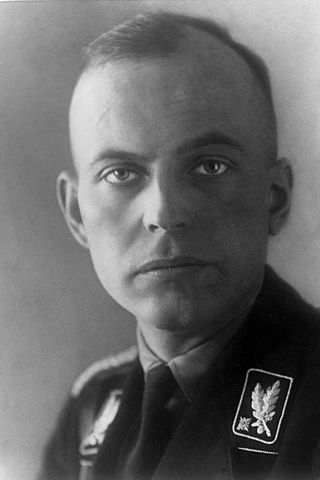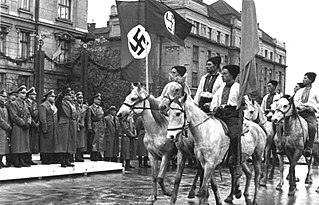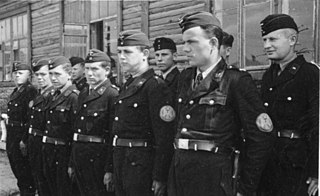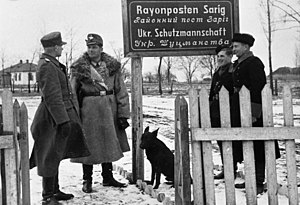
The Final Solution or the Final Solution to the Jewish Question was a Nazi plan for the genocide of individuals they defined as Jews during World War II. The "Final Solution to the Jewish question" was the official code name for the murder of all Jews within reach, which was not restricted to the European continent. This policy of deliberate and systematic genocide starting across German-occupied Europe was formulated in procedural and geopolitical terms by Nazi leadership in January 1942 at the Wannsee Conference held near Berlin, and culminated in the Holocaust, which saw the murder of 90% of Polish Jews, and two-thirds of the Jewish population of Europe. The Final Solution did not, however, include the hundreds of thousands of Jews killed by Romanian forces. By far the greatest extermination of Jews by non-German forces, this genocide was "operationally separate from the Nazi Final Solution".
The Lithuanian Activist Front or LAF was a short-lived, Lithuanian underground resistance organization established in 1940 after Lithuania was occupied by the Soviet Union. The goal of the organization was to liberate Lithuania and re-establish its independence. It planned and executed the June Uprising and established the short-lived Provisional Government of Lithuania. The Government self-disbanded and LAF was banned by Nazi authorities in September 1941. LAF remains controversial due to its anti-Semitic and anti-Polish positions.

Hans-Adolf Prützmann was among the highest-ranking German SS officials during the Nazi era. From June 1941 to September 1944, he served as a Higher SS and Police Leader in the occupied Soviet Union, and from November 1943 was the Supreme SS and Police Leader in Ukraine. He oversaw the activities of the Einsatzgruppen detachments that perpetrated the Holocaust in the Baltic States and Ukraine. After being captured at the end of the Second World War, he committed suicide.
In World War II, many governments, organizations and individuals collaborated with the Axis powers, "out of conviction, desperation, or under coercion." Nationalists sometimes welcomed German or Italian troops, believing they brought liberation from colonization. The Danish, Belgian, and Vichy French governments attempted to appease or bargain with the invaders, in hopes of mitigating harm to their citizens and economies. Some countries cooperated with Italy and Germany because they wanted to regain territory lost during and after the First World War or which their nationalist citizens simply coveted. Others, such as France, already had strong fascist movements and/or anti-semitic sentiment, which the invaders validated and empowered. Individuals such as Hendrik Seyffardt in the Netherlands and Theodoros Pangalos in Greece saw collaboration as a path to power in their country. Others believed that Germany would prevail, and either wanted to be on the winning side, or feared being on the losing one.
The Lithuanian Security Police (LSP), also known as Saugumas, was a local police force that operated in German-occupied Lithuania from 1941 to 1944, in collaboration with the occupational authorities. Collaborating with the Nazi Sipo and SD, the unit was directly subordinate to the German Kripo. The LSP took part in perpetrating the Holocaust in Lithuania, persecuting Polish resistance and communist underground.

Ukrainian collaboration with Nazi Germany took place during the occupation of Poland and the Ukrainian SSR, USSR, by Nazi Germany during the Second World War.
The Lithuanian TDA Battalion or TDA, was a paramilitary battalion organized in June–August 1941 by the Provisional Government of Lithuania at the onset of Operation Barbarossa. Members of the TDA were known by many names such as Lithuanian auxiliaries, policemen, white-armbands, nationalists, rebels, partisans, or resistance fighters. TDA was intended to be the basis for a future independent Lithuanian Army, but it was soon taken over by Nazis and reorganized into the Lithuanian Auxiliary Police Battalions. The original TDA eventually became the 12th and the 13th Police Battalions. These two units took an active role in mass killings of the Jews in Lithuania and Belarus. According to the Jäger Report, the TDA battalion's members killed about 26,000 Jews between July and December 1941.

The Holocaust in Belarus refers to the systematic extermination of Jews living in the Byelorussian Soviet Socialist Republic during its occupation by Nazi Germany in World War II. It is estimated that roughly 800,000 Belarusian Jews were murdered during the Holocaust. However, other estimates place the number of Jews killed between 500,000 and 550,000.

The Ukrainian Auxiliary Police was the official title of the local police formation set up by Nazi Germany during World War II in Eastern Galicia and Reichskommissariat Ukraine, shortly after the German occupation of the Western Ukrainian SSR in Operation Barbarossa.

The Belarusian Auxiliary Police was a German force established in July 1941 in occupied Belarus, staffed by local inhabitants, considered collaborationist. In western Belarus, auxiliary police were formed in the form of Schutzmanchaften units, while in the east they were formed in the form of Ordnungsdienst.

Latvian Auxiliary Police was a paramilitary force created from Latvian volunteers and conscripts by the Nazi German authorities who occupied the country in June/July 1941. It was part of the Schutzmannschaft (Shuma), native police forces organized by the Germans in occupied territories and subordinated to the Order Police. Some units of the Latvian auxiliary police were involved in the Holocaust.

Schutzmannschaft-Brigade Siegling was a Belarusian Auxiliary Police brigade formed by Nazi Germany in July 1944 in East Prussia, from six auxiliary police battalions following the Soviet Operation Bagration.

The military occupation of Lithuania by Nazi Germany lasted from the German invasion of the Soviet Union on June 22, 1941, to the end of the Battle of Memel on January 28, 1945. At first the Germans were widely welcomed as liberators from the repressive Soviet regime which occupied Lithuania prior to the German arrival. In hopes of re-establishing independence or regaining some autonomy, Lithuanians organized a Provisional Government. Thousands of Lithuanian nationalists then cooperated with the Generalkommissariat, jointly killing almost 200,000 Jews, which marks the highest death rate proportionally in any country during the Holocaust.
RollkommandoHamann was a small mobile unit that committed mass murders of Lithuanian Jews in the countryside in July–October 1941, with an estimated death toll of at least 60,000 Jews. The unit was also responsible for many murders in Latvia from July through August 1941. At the end of 1941 the destruction of Lithuanian Jewry was effectively accomplished by Hamann's unit in the countryside, by the Ypatingasis būrys in the Ponary massacre, and by the Tautinio Darbo Apsaugos Batalionas (TDA) in the Ninth Fort in Kaunas. In about six months an estimated 80% of all Lithuanian Jews were killed. The remaining few were spared for use as a labor force and concentrated in urban ghettos, mainly the Vilna and Kaunas Ghettos.
Estonian Auxiliary Police were Estonian collaborationist police units during World War II.
Ukrainian People's Militsiya or the Ukrainian National Militsiya, was a paramilitary formation created by the Organization of Ukrainian Nationalists (OUN) in the General Government territory of occupied Poland and later in the Reichskommissariat Ukraine during World War II. It was set up in the course of Operation Barbarossa, the 1941 invasion of the Soviet Union.
The Litauische Bau-Bataillonen or Lithuanian Construction Battalions were five auxiliary pioneer battalions of the Wehrmacht during World War II. Formed in 1943, they consisted mostly of conscripted Lithuanians with only a small number of Germans. In total, about 2,500–3,000 men served in the battalions. They were attached to German engineering units under the Army Group North. They were sent to the Eastern Front where they constructed and repaired roads, bridges, bunkers, anti-tank obstacles, and other military fortifications. They were labor units though they engaged Soviet partisans on several occasions. A few times, Lithuanian formations were used to plunder and burn Russian villages according to German scorched earth tactics. The battalions were disbanded and absorbed by various other units in 1944.

The Lithuanian Auxiliary Police Battalions were Schutzmannschaft battalions formed during the German occupation of Lithuania between 1941 and 1944, with the first battalions originating from the most reliable freedom fighters that were disbanded following the anti-Soviet Lithuanian June Uprising in 1941. Lithuanian activists hoped that these units would be the basis of the reestablished Lithuanian Army and commanded by the Lithuanian Provisional Government. Instead, these units were placed under the orders of the SS- und Polizeiführer in Lithuania. The battalions were charged with internal security duties and engaged in anti-partisan operations in the Wehrmacht's rear areas, e.g. Ukraine, Belarus, Poland and Northwest Russia.
10th Lithuanian Police Battalion was a Lithuanian auxiliary police battalion first formed in August 1941 and disbanded on 31 January 1943. The original 10th Battalion is known to have partaken in the Holocaust. A new battalion with the same name was formed after a few months and was renumbered as 256th Lithuanian Police Battalion.
Wartime collaboration occurred in every country occupied by Nazi Germany during the Second World War, including the Baltic states. The three Baltic republics of Estonia, Latvia and Lithuania, first invaded and occupied by the Soviet Union in summer 1940, were later occupied by Germany in summer 1941 and incorporated, together with parts of the Byelorussian Soviet Socialist Republic of the U.S.S.R., into Reichskommissariat Ostland. Collaborators with Germany participated in the Eastern Front against the Soviet Union, as well as in the Holocaust, both in and outside of the Baltic States. This collaboration was done through formal Waffen-SS divisions and police battalions, as well as through spontaneous acts during the opening of the war.











